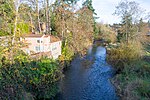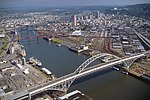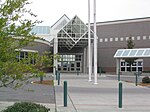Vancouver Lake

Vancouver Lake is located just west of Vancouver, Washington, United States, north of the Columbia River and Portland, Oregon, south of Ridgefield, Washington, and the Ridgefield National Wildlife Refuge. The lake is shallow, with a maximum depth of 12 to 15 feet (3.7 to 4.6 m) and a mean depth of less than 3 feet (0.9 m). There is an island in the northern half of the lake named Turtle Island. The island was formed from the tailings of an Army Corps of Engineers dredging project, which dredged around the perimeter of the lake in the early 1980s. Lake River flows from the north shore to the Columbia River near Ridgefield. Due to seasonal variation in relative river and lake levels, Lake River experiences intermittent flow reversal and flows into Vancouver Lake for considerable periods of time. The sources for Vancouver Lake's water include a flushing channel (equipped with tidal gates to control flows) from the Columbia River near the southwest shoreline and Burnt Bridge Creek on the eastern shoreline, which winds about ten miles (sixteen kilometres) through many of the city's residential areas. Until the 1980s, this creek was neglected and a major source of pollution for the lake. Lower River Road leads west out of Vancouver to a park on the shore of Vancouver Lake which includes a large swimming area. A trail leads to Frenchman's Bar Park on the nearby Columbia River.
Excerpt from the Wikipedia article Vancouver Lake (License: CC BY-SA 3.0, Authors, Images).Vancouver Lake
Geographical coordinates (GPS) Address Nearby Places Show on map
Geographical coordinates (GPS)
| Latitude | Longitude |
|---|---|
| N 45.6779 ° | E -122.721 ° |
Address
West Hazel Dell
Washington, United States
Open on Google Maps










